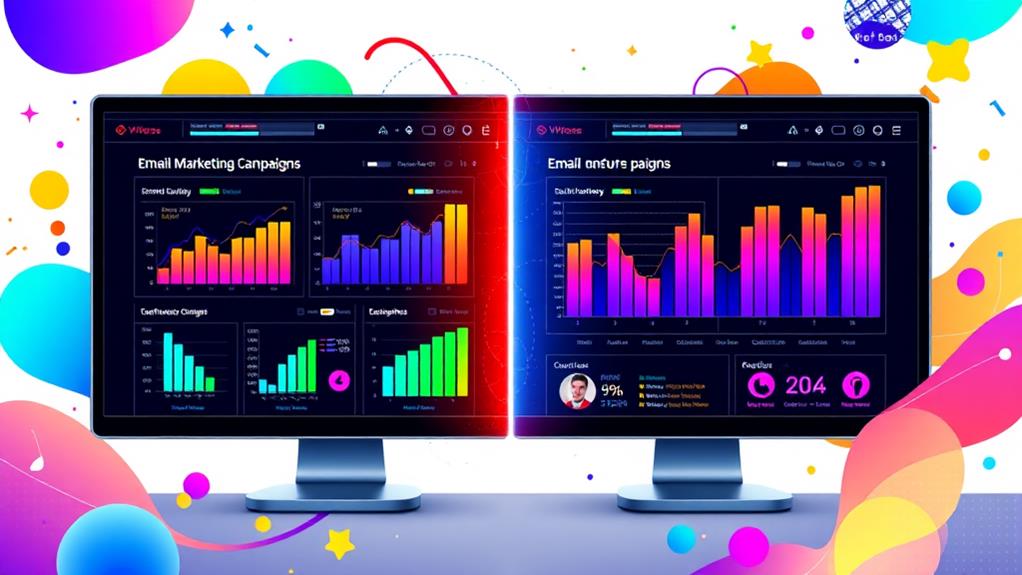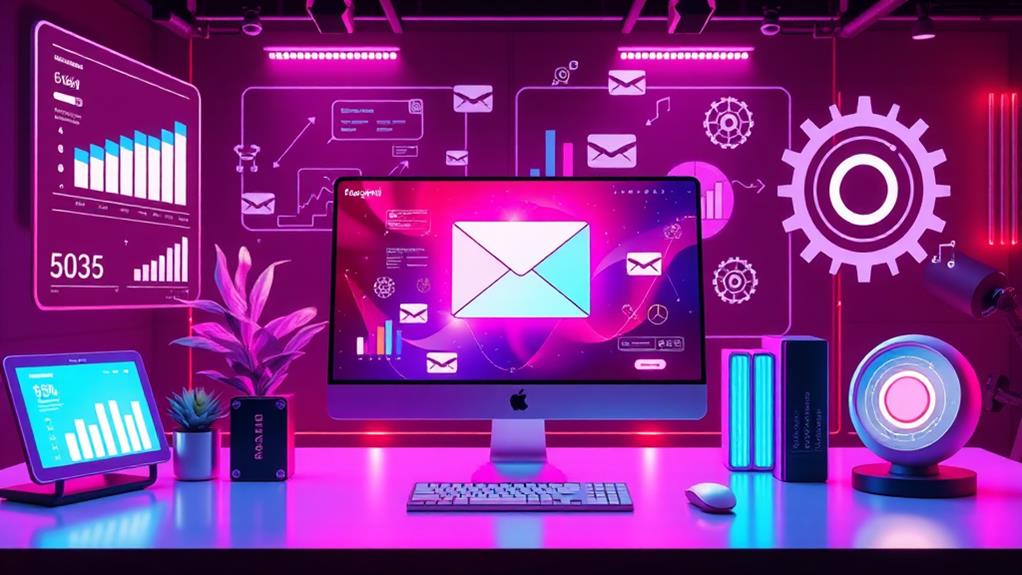To create a simple yet effective welcome email series for new subscribers, strategically plan a sequence of 4-6 emails over 30 days. Initial emails should welcome and introduce your brand, aligning with your vision to boost retention by 33%. Utilize personalization to enhance engagement, noting that personalized emails can increase open rates by 8.92%. Each email must focus on clear goals, such as achieving a 20% conversion rate. Incorporate interactive elements and compelling CTAs to guide the subscriber journey effectively. Automation guarantees timely delivery and personalization. Master these elements, and your approach will drive both trust and conversions.
Key Takeaways
- Define clear goals to align with your brand vision and ensure measurable outcomes for the welcome email series.
- Structure a 4-6 email sequence over 30 days, starting with a warm welcome to engage subscribers effectively.
- Personalize content and use dynamic elements to enhance engagement and click-through rates.
- Implement automation to ensure timely and consistent communication with new subscribers.
- Continuously monitor performance metrics and adjust strategies to maintain relevance and improve effectiveness.
Importance of Welcome Emails
Welcome emails hold a fundamental role in the onboarding process of new subscribers, with their strategic importance underscored by compelling statistics. Achieving an impressive average open rate of 55.61%, these emails surpass standard marketing emails in capturing attention, making them a vital initial touchpoint.
This effectiveness is further demonstrated by their capability to generate 320% more revenue than regular promotional emails, highlighting their potential to drive early purchases. Subscribers expect prompt communication, with 74% anticipating a welcome email immediately after signing up. This underscores the need for businesses to meet subscriber expectations to foster engagement and satisfaction.
The raised click-through rates of welcome emails, four times higher than other types, illustrate their powerful influence on subscriber engagement. They are instrumental in establishing positive first impressions, a key step in building trust and setting the foundation for enduring customer relationships.
Setting Clear Goals
Setting clear goals for your welcome email series is essential for maximizing engagement and conversion rates. By defining precise conversion objectives, businesses can leverage the fact that emails with clear purposes are 2.3 times more effective at converting subscribers.
Aligning these objectives with your brand's vision not only improves customer retention but also enhances customer lifetime value by 33%. This ensures that your welcome emails resonate with new subscribers and strategically drive desired outcomes.
Define Conversion Objectives
Defining conversion objectives is a critical step in crafting an effective welcome email series, as it aligns each communication with overarching business goals and guarantees purposeful engagement with new subscribers. By setting specific goals, such as driving first-time purchases or encouraging social media follows, businesses can refine their strategies to meet measurable targets.
For instance, aiming for a 20% conversion rate enables conversion tracking, providing a concrete benchmark for evaluating the success of the email series. The precision of these objectives guarantees that each email in the series maintains focus on the sales funnel, gradually guiding subscribers from awareness to action.
This strategic approach not only boosts customer engagement but also fosters long-term loyalty. Utilizing data from previous campaigns, like average open rates of 55.61% and conversion rates of 2.38%, can inform realistic and achievable goals, making the welcome series more effective.
Regular goal refinement, based on subscriber behavior and feedback, is essential. This iterative process guarantees the welcome series remains relevant and continues to resonate with new audiences.
Adjusting objectives dynamically not only enhances performance but also maximizes the potential for impactful results, ultimately driving business growth.
Align With Brand Vision
To guarantee a welcome email series is both impactful and coherent, aligning it with the brand vision is essential. Brand consistency in the messaging tone not only fosters trust but also enhances recognition among new subscribers. This is vital, considering that 74% of subscribers expect an immediate welcome email that resonates with the brand they subscribed to.
Setting clear goals for the welcome series, such as driving first-time purchases or increasing engagement, capitalizes on the fact that welcome emails achieve four times higher open rates compared to standard emails.
By establishing a structured approach with distinct objectives at each stage, you guide subscribers through the sales funnel while reinforcing your brand identity and values. Incorporating your brand's unique value proposition differentiates your offerings from competitors, thereby increasing loyalty and retention.
This strategic alignment guarantees that your welcome series not only attracts attention but also converts interest into action. Regular performance reviews against established goals allow for continuous improvement. This guarantees the welcome series remains aligned with your evolving brand vision and subscriber expectations, maintaining brand consistency.
Ultimately, this approach ensures your welcome emails are not just messages, but powerful tools for conversion and engagement.
Structuring Your Email Series
To effectively structure a welcome email series, a strategic sequence of 4-6 emails is essential, with each email crafted to engage new subscribers over 30 days.
Data shows that initiating contact immediately with the first email post-sign-up meets the expectations of 74% of subscribers, thereby enhancing engagement.
Email Sequence Strategy
Crafting an effective email sequence strategy is essential for converting new subscribers into loyal customers. The key lies in meticulously structuring your email series to synchronize with the subscriber journey, optimizing email timing to maintain engagement.
A well-planned sequence typically includes 4-6 emails, each with a unique role in onboarding new subscribers and enhancing their connection with the brand. The timing of these emails is vital; dispatching them daily or within a few days apart helps sustain momentum and keeps the subscriber engaged during the initial interaction phase.
The first email should extend a warm welcome, setting the tone for the relationship. Subsequent emails can strategically introduce team members, elucidate expectations, and offer valuable resources or checklists pertinent to your offerings.
Personalization plays a pivotal role in this strategy. Tailoring content to subscriber preferences—incorporating their name and specific interests—can greatly uplift open rates and engagement levels. For instance, personalized subject lines have been shown to boost open rates by nearly 9%.
Each email should feature compelling calls-to-action (CTAs) to drive desired behaviors, such as encouraging purchases, soliciting feedback, or promoting social media engagement.
Engaging Content Elements
While structuring your email series, incorporating engaging content elements is pivotal for maximizing subscriber engagement and conversion rates. A personal welcome message sets a positive tone, immediately creating a connection and alleviating the initial anxiety that new subscribers might feel. This initial approach builds trust and sets expectations, enhancing their willingness to engage further.
To deepen the connection, introduce the team or share behind-the-scenes insights, adding a human touch to the digital interaction. In addition, integrating interactive elements like quizzes or surveys can greatly boost engagement. These features not only make the experience enjoyable but also provide valuable data on subscriber preferences. This data allows for refined personalization in subsequent communications, aligning with individual interests and increasing overall effectiveness.
Strategically placed calls-to-action (CTAs) within each email, especially towards the series' conclusion, drive subscribers to take meaningful actions, such as completing a purchase or providing feedback. Additionally, a checklist of necessary documents or steps to follow enhances the onboarding process, ensuring subscribers feel informed and prepared.
Crafting Engaging Content
A well-crafted welcome email series is a strategic asset in engaging new subscribers, with data showing an impressive average open rate of 55.61%. This makes these emails markedly more effective than standard marketing communications. To capitalize on this, employing effective engagement techniques and diverse content formats is vital.
Start by incorporating a clear value proposition to immediately answer, "What's in it for me?" This sets the tone for future interactions and enhances subscriber engagement.
Personalization techniques, such as using the recipient's name and tailoring content to preferences, can boost open rates by 8.92%. This fosters a personalized connection with subscribers, making them feel valued.
Additionally, integrating interactive elements like quizzes or surveys not only boosts engagement but can also increase click-through rates, creating a sense of community and involvement.
Compelling subject lines and clear calls-to-action (CTAs) are essential; with 47% of recipients opening emails based on the subject line alone, crafting intriguing and relevant messages becomes important.
Each element within your welcome email should work cohesively to guide new subscribers towards meaningful engagement, setting a strong foundation for future communication and relationship-building.
Best Practices for Automation
Implementing automation in a welcome email series is a transformative strategy that guarantees consistent and timely communication with new subscribers. By leveraging automation tools, businesses can achieve open rates of approximately 55.61%, markedly outperforming standard email campaigns.
The strategic deployment of trigger settings is vital, as these determine when an automated email is sent based on subscriber actions, such as sign-up confirmation. This precision reduces human error and guarantees that communications are delivered at ideal engagement points.
Utilizing email marketing platforms with robust automation tools enables the setup of a series of 4-6 emails delivered over a carefully defined timeframe. This approach aligns with peaks in subscriber engagement, thereby enhancing the likelihood of positive interaction.
Continuous monitoring of performance metrics, including click-through rates and conversions, is essential for refining the welcome series. This data-driven approach allows for ongoing adjustments, guaranteeing the series remains effective and relevant.
Incorporating automation in your email strategy not only streamlines operations but also maximizes resource allocation. By focusing on trigger settings and leveraging advanced automation tools, businesses can maintain a strong connection with new subscribers, fostering long-term engagement and increasing conversion potential.
Personalization and Segmentation
Incorporating personalization and segmentation into a welcome email series is a strategic imperative that considerably enhances subscriber engagement and conversion rates. By leveraging dynamic personalization, where recipient names are seamlessly integrated into subject lines, open rates can increase by up to 8.92%. This initial engagement paves the way for deeper connections.
Audience insights derived from segmentation are equally powerful; tailoring messages to specific subscriber preferences or behaviors can boost sales by 70%. This is achieved by crafting multiple welcome sequences that align with the subscriber's entry point, be it through a lead magnet or a purchase, thereby enhancing relevance.
Further, collecting data through surveys or preference forms during the welcome series equips businesses with valuable insights for future customization. With this information, dynamic content can be employed, enhancing user experience by adjusting email content based on subscriber segments.
This approach not only increases click-through rates but also drives conversions by ensuring that content resonates with individual subscriber needs. To sum up, personalization and segmentation are not merely options but necessities for an effective welcome email series, offering a significant return on investment through increased engagement and targeted communication.
Measuring Success and Adjusting
Effectively measuring success and making informed adjustments in a welcome email series is essential for maximizing engagement and conversion rates. By tracking performance metrics such as open rates, click-through rates, and conversion rates, marketers can gauge the effectiveness of each email, with open rates potentially reaching up to 55.61%. These metrics provide a quantitative foundation for evaluating the series' impact and identifying areas requiring enhancement.
Incorporating A/B testing into your strategy allows for data-driven comparisons of subject lines, content, and calls-to-action (CTAs), revealing which variations maximize engagement and conversion rates. This approach facilitates content optimization and behavior adaptation, guaranteeing each email resonates with subscribers.
Monitoring subscriber retention rates post-welcome series further informs long-term engagement strategies, highlighting opportunities for strengthening loyalty. Feedback analysis, through surveys or direct input requests, offers qualitative insights that drive iterative improvements.
Regularly analyzing performance data and engagement trends enables marketers to adjust email content and frequency, aligning with evolving subscriber behaviors. Such agility in refining the welcome series not only enhances immediate results but also builds a robust framework for sustained subscriber engagement and retention.
This continuous cycle of measurement and adaptation guarantees the welcome series remains an effective tool in the marketing arsenal.
Frequently Asked Questions
How to Write the Perfect Welcome Email for New Subscribers?
To craft the perfect welcome email for new subscribers, prioritize personalization tips and strategic subject lines. Utilize data-driven insights, such as incorporating recipient names and concise, engaging subjects, to enhance open rates and foster immediate brand connection.
What Is an Example of a Welcome Series?
An exemplary welcome series enhances subscriber engagement through email personalization by introducing the brand, offering exclusive incentives, and sharing valuable content. This strategic approach maximizes open rates and revenue, effectively converting new subscribers into loyal customers.
How Many Emails Should a Welcome Series Have?
A three email strategy, taking timing considerations into account, effectively balances engagement and subscriber interest. This approach aligns with research showing that concise, well-timed communication optimizes conversion rates without overwhelming new subscribers, ensuring sustained interaction and brand loyalty.
How Can I Improve My Welcome Series?
Enhance your welcome series by prioritizing subscriber engagement through email personalization, leveraging data-driven insights to tailor content. Incorporate compelling CTAs and urgency, while continuously monitoring metrics to refine strategies for ideal conversion and engagement outcomes.
Conclusion
In summary, a strategically crafted welcome email series is integral to fostering subscriber engagement and retention. By setting clear objectives, structuring a coherent series, and crafting compelling content, organizations can enhance the effectiveness of their communication efforts. Employing best practices in automation, along with personalization and segmentation, further augments the impact of these emails. Continuous measurement and adjustment based on data-driven insights guarantee that the welcome series remains relevant and effective, ultimately contributing to the organization's overall marketing success.




